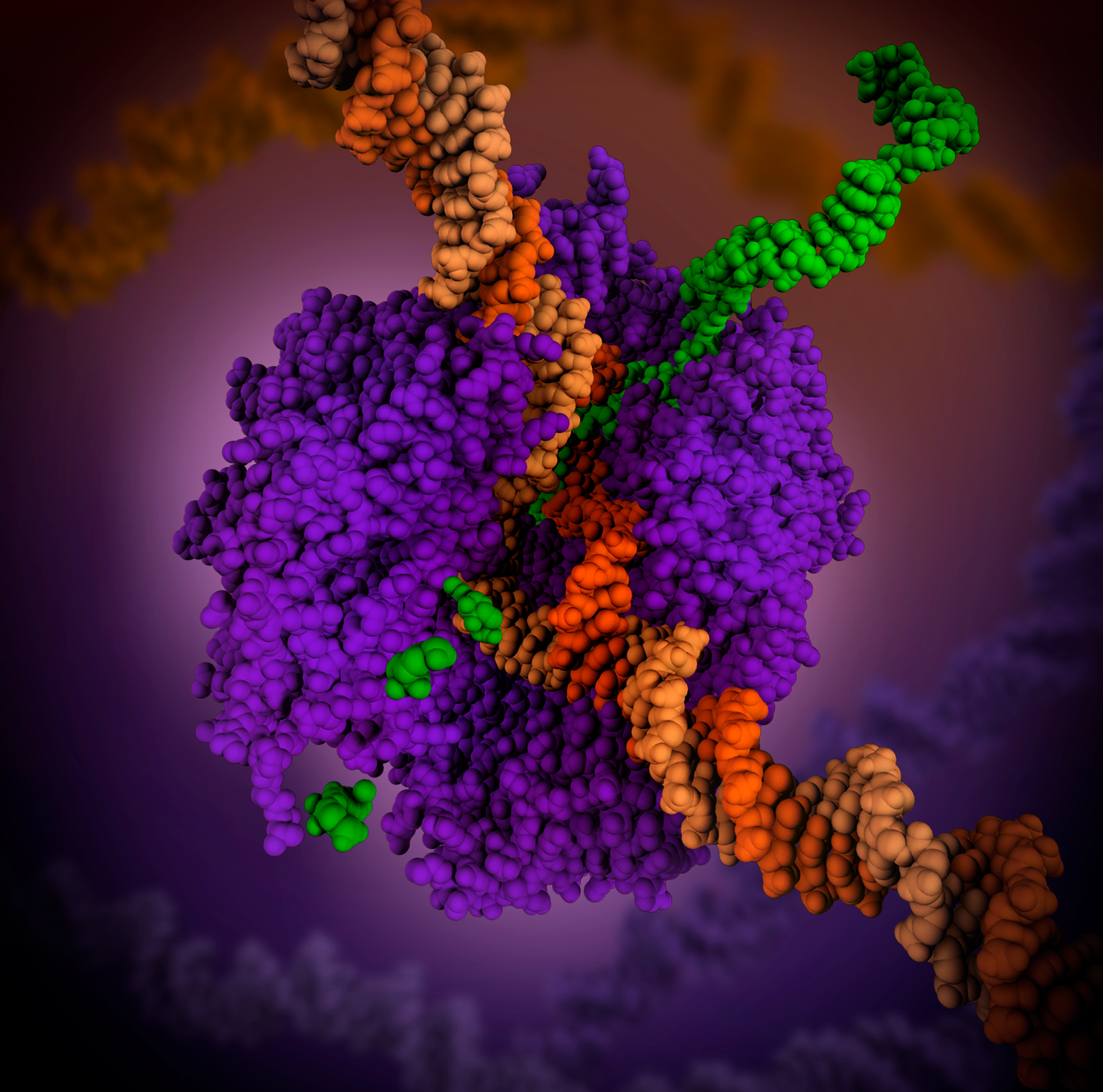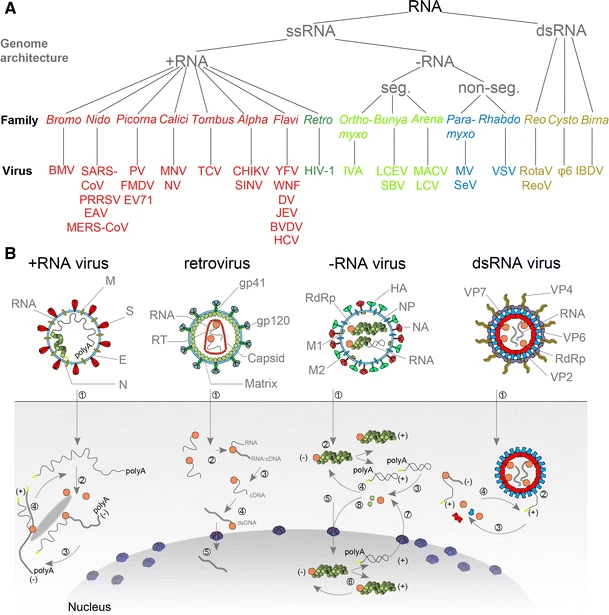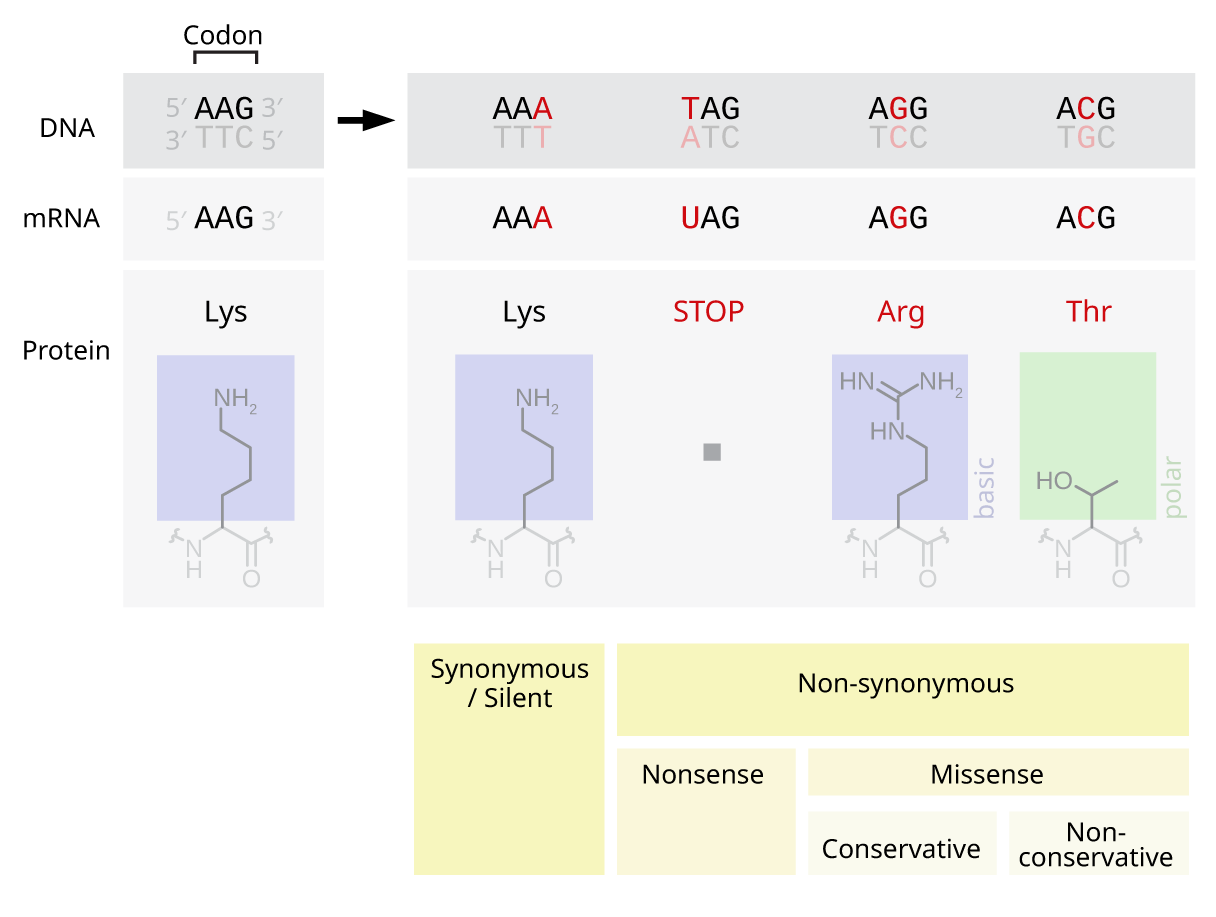|
Antigenic Drift
Antigenic drift is a kind of genetic variation in viruses, arising from the accumulation of mutations in the virus genes that code for virus-surface proteins that host antibodies recognize. This results in a new strain of virus particles that is not effectively inhibited by the antibodies that prevented infection by previous strains. This makes it easier for the changed virus to spread throughout a partially immune population. Antigenic drift occurs in both and viruses. (Confusion can arise with two very similar terms, antigenic shift and genetic drift. Antigenic shift is a closely related process; it refers to the more dramatic changes in the virus's surface proteins when the genetic material from two or more viruses mix together. Genetic drift is very different and much more broadly applicable; it refers to the gradual accumulation in any DNA sequence of random mutational changes that do not interfere with the DNA's function and thus that are not seen by natural selection. ... [...More Info...] [...Related Items...] OR: [Wikipedia] [Google] [Baidu] |
Mutation
In biology, a mutation is an alteration in the nucleic acid sequence of the genome of an organism, virus, or extrachromosomal DNA. Viral genomes contain either DNA or RNA. Mutations result from errors during DNA or viral replication, mitosis, or meiosis or other types of damage to DNA (such as pyrimidine dimers caused by exposure to ultraviolet radiation), which then may undergo error-prone repair (especially microhomology-mediated end joining), cause an error during other forms of repair, or cause an error during replication ( translesion synthesis). Mutations may also result from substitution, insertion or deletion of segments of DNA due to mobile genetic elements. Mutations may or may not produce detectable changes in the observable characteristics ( phenotype) of an organism. Mutations play a part in both normal and abnormal biological processes including: evolution, cancer, and the development of the immune system, including junctional diversity. Mutati ... [...More Info...] [...Related Items...] OR: [Wikipedia] [Google] [Baidu] |
Selection Pressure
Evolutionary pressure, selective pressure or selection pressure is exerted by factors that reduce or increase reproductive success in a portion of a population, driving natural selection. It is a quantitative description of the amount of change occurring in processes investigated by evolutionary biology, but the formal concept is often extended to other areas of research. In population genetics, selective pressure is usually expressed as a selection coefficient. Amino acids selective pressure It has been shown that putting an amino acid bio-synthesizing gene like ''HIS4'' gene under amino acid selective pressure in yeast causes enhancement of expression of adjacent genes which is due to the transcriptional co-regulation of two adjacent genes in Eukaryota. Antibiotic resistance Drug resistance in bacteria is an example of an outcome of natural selection. When a drug is used on a species of bacteria, those that cannot resist die and do not produce offspring, while those that s ... [...More Info...] [...Related Items...] OR: [Wikipedia] [Google] [Baidu] |
Flu Season
Flu season is an annually recurring time period characterized by the prevalence of an outbreak of influenza (flu). The season occurs during the cold half of the year in each hemisphere. It takes approximately two days to show symptoms. Influenza activity can sometimes be predicted and even tracked geographically. While the beginning of major flu activity in each season varies by location, in any specific location these minor epidemics usually take about three weeks to reach its pinnacle, and another three weeks to significantly diminish. Annually, about 3 to 5 million cases of severe illness and 290,000 to 650,000 deaths from seasonal flu occur worldwide. Cause Three virus families, Influenza virus A, B, and C are the main infective agents that cause influenza. During periods of cooler temperature, influenza cases increase roughly tenfold or more. Despite the higher incidence of manifestations of the flu during the season, the viruses are actually transmitted througho ... [...More Info...] [...Related Items...] OR: [Wikipedia] [Google] [Baidu] |
Immunity (medical)
In biology, immunity is the state of being insusceptible or resistant to a noxious agent or process, especially a pathogen or infectious disease. Immunity may occur naturally or be produced by prior exposure or immunization. Innate and adaptive The immune system has Innate immune system, innate and Adaptive immune system, adaptive components. Innate immunity is present in all metazoans, immune responses: inflammation, inflammatory responses and phagocytosis. The adaptive component, on the other hand, involves more advanced lymphocyte, lymphatic cells that can distinguish between specific "non-self" substances in the presence of "self". The reaction to foreign substances is etymologically described as inflammation while the non-reaction to self substances is described as immunity. The two components of the immune system create a dynamic biological environment where "health" can be seen as a physical state where the self is immunologically spared, and what is foreign is inflammat ... [...More Info...] [...Related Items...] OR: [Wikipedia] [Google] [Baidu] |
RNA Polymerase
In molecular biology, RNA polymerase (abbreviated RNAP or RNApol), or more specifically DNA-directed/dependent RNA polymerase (DdRP), is an enzyme that catalyzes the chemical reactions that synthesize RNA from a DNA template. Using the enzyme helicase, RNAP locally opens the double-stranded DNA so that one strand of the exposed nucleotides can be used as a template for the synthesis of RNA, a process called transcription. A transcription factor and its associated transcription mediator complex must be attached to a DNA binding site called a promoter region before RNAP can initiate the DNA unwinding at that position. RNAP not only initiates RNA transcription, it also guides the nucleotides into position, facilitates attachment and elongation, has intrinsic proofreading and replacement capabilities, and termination recognition capability. In eukaryotes, RNAP can build chains as long as 2.4 million nucleotides. RNAP produces RNA that, functionally, is either for protei ... [...More Info...] [...Related Items...] OR: [Wikipedia] [Google] [Baidu] |
RNA Viruses
''Orthornavirae'' is a kingdom of viruses that have genomes made of ribonucleic acid (RNA), including genes which encode an RNA-dependent RNA polymerase (RdRp). The RdRp is used to transcribe the viral RNA genome into messenger RNA (mRNA) and to replicate the genome. Viruses in this kingdom share a number of characteristics which promote rapid evolution, including high rates of genetic mutation, recombination, and reassortment. Viruses in ''Orthornavirae'' belong to the realm ''Riboviria''. They are descended from a common ancestor that may have been a non-viral molecule that encoded a reverse transcriptase instead of an RdRp for replication. The kingdom is subdivided into seven phyla that separate member viruses based on their genome type, host range, and genetic similarity. Viruses with three genome types are included: positive-strand RNA viruses, negative-strand RNA viruses, and double-stranded RNA viruses. Many of the most widely known viral diseases are caused by membe ... [...More Info...] [...Related Items...] OR: [Wikipedia] [Google] [Baidu] |
Genetic Code
Genetic code is a set of rules used by living cell (biology), cells to Translation (biology), translate information encoded within genetic material (DNA or RNA sequences of nucleotide triplets or codons) into proteins. Translation is accomplished by the ribosome, which links proteinogenic amino acids in an order specified by messenger RNA (mRNA), using transfer RNA (tRNA) molecules to carry amino acids and to read the mRNA three nucleotides at a time. The genetic code is highly similar among all organisms and can be expressed in a simple table with 64 entries. The codons specify which amino acid will be added next during protein biosynthesis. With some exceptions, a three-nucleotide codon in a nucleic acid sequence specifies a single amino acid. The vast majority of genes are encoded with a single scheme (see the Codon tables, RNA codon table). That scheme is often called the canonical or standard genetic code, or simply ''the'' genetic code, though #Variations, variant codes (suc ... [...More Info...] [...Related Items...] OR: [Wikipedia] [Google] [Baidu] |
Point Mutations
A point mutation is a genetic mutation where a single nucleotide base is changed, inserted or deleted from a DNA or RNA sequence of an organism's genome. Point mutations have a variety of effects on the downstream protein product—consequences that are moderately predictable based upon the specifics of the mutation. These consequences can range from no effect (e.g. synonymous mutations) to deleterious effects (e.g. frameshift mutations), with regard to protein production, composition, and function. Causes Point mutations usually take place during DNA replication. DNA replication occurs when one double-stranded DNA molecule creates two single strands of DNA, each of which is a template for the creation of the complementary strand. A single point mutation can change the whole DNA sequence. Changing one purine or pyrimidine may change the amino acid that the nucleotides code for. Point mutations may arise from spontaneous mutations that occur during DNA replication. The rate of ... [...More Info...] [...Related Items...] OR: [Wikipedia] [Google] [Baidu] |
Avidity
In biochemistry, avidity refers to the accumulated strength of ''multiple'' affinities of individual non-covalent binding interactions, such as between a protein receptor and its ligand, and is commonly referred to as functional affinity. Avidity differs from affinity, which describes the strength of a ''single'' interaction. However, because individual binding events increase the likelihood of occurrence of other interactions (i.e., increase the local concentration of each binding partner in proximity to the binding site), avidity should not be thought of as the mere sum of its constituent affinities but as the combined effect of all affinities participating in the biomolecular interaction. A particular important aspect relates to the phenomenon of 'avidity entropy'. Biomolecules often form heterogenous complexes or homogeneous oligomers and multimers or polymers. If clustered proteins form an organized matrix, such as the clathrin-coat, the interaction is described as a matrici ... [...More Info...] [...Related Items...] OR: [Wikipedia] [Google] [Baidu] |
Virion
A virion (plural, ''viria'' or ''virions'') is an inert virus particle capable of invading a Cell (biology), cell. Upon entering the cell, the virion disassembles and the genetic material from the virus takes control of the cell infrastructure, thus enabling the virus to Replication (virus), replicate. The genetic material (''Viral core, core'', either DNA or RNA, along with occasionally present virus core protein) inside the virion is usually enclosed in a protection shell, known as the capsid. While the terms "virus" and "virion" are occasionally confused, recently "virion" is used solely to describe the virus structure outside of cells, while the terms "virus/viral" are broader and also include biological properties such as the infectivity of a virion. Components A virion consists of one or more nucleic acid genome molecules (single-stranded or double-stranded RNA or DNA) and coatings (a capsid and possibly a viral envelope). The virion may contain other proteins (for examp ... [...More Info...] [...Related Items...] OR: [Wikipedia] [Google] [Baidu] |
Neuraminidase
Exo-α-sialidase (, sialidase, neuraminidase; systematic name acetylneuraminyl hydrolase) is a glycoside hydrolase that cleaves the glycosidic linkages of neuraminic acids: : Hydrolysis of α-(2→3)-, α-(2→6)-, α-(2→8)- glycosidic linkages of terminal sialic acid residues in oligosaccharides, glycoproteins, glycolipids, colominic acid and synthetic substrates Neuraminidase Enzyme, enzymes are a large family, found in a range of organisms. The best-known neuraminidase is the viral neuraminidase, a drug target for the prevention of the spread of influenza infection. Viral neuraminidase was the first neuraminidase to be identified. It was discovered in 1957 by Alfred Gottschalk (biochemist), Alfred Gottschalk at the WEHI, Walter and Eliza Hall Institute in Melbourne. The viral neuraminidases are frequently used as antigenic determinants found on the surface of the influenza virus. Some variants of the influenza neuraminidase confer more virulence to the virus than others. Ot ... [...More Info...] [...Related Items...] OR: [Wikipedia] [Google] [Baidu] |





